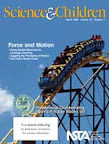Learning about motion and appropriate restraints
By Peggy Ashbrook
Posted on 2009-02-09

 Some children chafe at any restriction, including car seat straps. Doing an activity about force and motion may not make them any happier to be strapped in but it may help them understand what could happen if they weren’t restrained during an accident. The March 2009 Early Years column in Science and Children provides instructions for discussing child passenger safety while modeling a car and passenger using a cup and marble. Children look at me curiously when I tell them, “This is me (holding up the marble) and this cup is my car. I’m going for a drive.” They all want to ‘drive,’ and we do—after they tell me how I can stay safely in my seat in the event of another car getting in the way. They propose seatbelts which we make out of tape. First we drive without ‘seatbelts’ because this is pretend, then with the ‘seatbelts’ to see what happens. The children are repeating the experiment. Through experience they understand more fully that a loose marble will continue to roll even when the cup that was holding it is stopped.
Some children chafe at any restriction, including car seat straps. Doing an activity about force and motion may not make them any happier to be strapped in but it may help them understand what could happen if they weren’t restrained during an accident. The March 2009 Early Years column in Science and Children provides instructions for discussing child passenger safety while modeling a car and passenger using a cup and marble. Children look at me curiously when I tell them, “This is me (holding up the marble) and this cup is my car. I’m going for a drive.” They all want to ‘drive,’ and we do—after they tell me how I can stay safely in my seat in the event of another car getting in the way. They propose seatbelts which we make out of tape. First we drive without ‘seatbelts’ because this is pretend, then with the ‘seatbelts’ to see what happens. The children are repeating the experiment. Through experience they understand more fully that a loose marble will continue to roll even when the cup that was holding it is stopped.
Note that not all children think of using seatbelts to restrain their marble-drivers, notably those whose families do not own a car. They still enjoy the activity and taking home an information sheet for adults. Here are websites for such information:
 The Washington State Booster Seat Coalition: Download these one-page informative flyers at no cost to raise awareness about booster seat basics. They are available in Amharic, Arabic, English, Chinese, Japanese, Khmer, Korean, Oromo, Russian, Somali, Spanish, Tagalog, Tigrinva, and Vietnamese.
The Washington State Booster Seat Coalition: Download these one-page informative flyers at no cost to raise awareness about booster seat basics. They are available in Amharic, Arabic, English, Chinese, Japanese, Khmer, Korean, Oromo, Russian, Somali, Spanish, Tagalog, Tigrinva, and Vietnamese.
The Children’s Hospital of Philadelphia: Information in English and Spanish, including videos that teach the appropriate restraints according to the child’s age and size.
Transportation Safety Tips for Children, the National Highway Traffic Safety Administration: A set of 11 topics, including riding in a car, bus, on a bike, and walking, these pages fully describe the rational behind using different car seat restraints at different ages and describe child development, such as, “Children can’t judge speed and they think cars can stop instantly.” Copy the pages to share with the families of your students.
Children enjoy exploring motion.
Peggy
Disclaimer: The views expressed in this blog post are those of the author(s) and do not necessarily reflect the official position of the National Science Teaching Association (NSTA).


